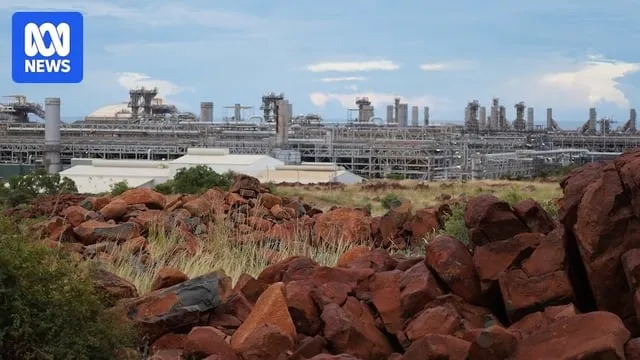Introduction
The recent approval of Woodside’s North West Shelf gas project by the Australian government has placed the spotlight on the balancing act between energy needs and environmental preservation. With a life extension granted until 2070, concerns surrounding the impact of this extension on Australia’s rich Indigenous heritage and fragile ecosystems have intensified.
Woodside’s North West Shelf: An Overview
Woodside Petroleum, an Australian oil and gas company, operates the North West Shelf (NWS) project, Australia’s largest gas development. Located off the coast of Western Australia, the NWS project has been a linchpin in the country’s energy landscape since its inception in the 1980s. It has played a critical role in supplying liquefied natural gas (LNG) to international markets and fostering economic growth within the region.
The recent governmental approval for an extension of the project is expected to facilitate continued production at the site, contributing to both job creation and economic stability in the area. However, these economic benefits stand in stark contrast to environmental concerns raised by activists and Indigenous communities.
Economic Considerations vs. Environmental Protection
Proponents of the project argue that extending the NWS gas plant is vital for ensuring Australia remains a competitive player in the global energy market. With the world’s appetite for natural gas rising, tapping into available resources is seen as an essential strategy to secure energy security and national interests.
Critics, on the other hand, argue that prioritizing immediate economic benefits over long-term environmental health poses significant risks. The NWS is situated amid the Murujuga region, home to over 50,000-year-old rock art that is not only a cultural treasure but also crucial to the identity of the Indigenous people of the area.
Impact on Murujuga’s Rock Art
Murujuga, also known as the Burrup Peninsula, boasts one of the world’s most significant collections of rock engravings, embedding it deeply in the cultural history of the Indigenous peoples of Australia. It is estimated that there are over a million petroglyphs on Murujuga, depicting ancient animal species, human figures, and intricate patterns.
The extension of the NWS project raises pressing concerns regarding the protection of this heritage. Experts warn that increased industrial activity, pollution, and climate impact could jeopardize the preservation of these remarkable engravings. The approval of the extension has reignited discussions about how much weight should be placed on protecting cultural and historical artifacts against economic output from gas projects.
Government’s Stance
The Australian government, led by the Labor party, has made it clear that it sees LNG as a transitional energy source while aiming for a more sustainable future. The government argues that extending the NWS project is a pivotal step in facilitating a transition to renewable energy sources in the coming decades.
However, critics have pointed to a dichotomy in this argument, asserting that exacerbating fossil fuel dependence undermines the very ideals of transitioning to greener energy practices. Critics believe that the message sent through this approval is one of prioritizing short-term economic gains rather than genuinely committing to the climate actions required to protect both the environment and Indigenous heritage.
Indigenous Voices and Advocacy
The voices of local Indigenous communities have been critical in the fight against the NWS expansion. Leaders from these communities have expressed profound disappointment with the government’s decision, emphasizing the need to protect Murujuga as a sacred site. There is a shared sentiment that Indigenous consulting should be prioritized, and their opinions taken into serious consideration before such approvals are granted.
Protests have erupted, calling for a halt to the expansion of gas extraction initiatives that threaten both their lands and their cultural heritage. Activists have taken to social media, organizing campaigns and rallies to raise awareness about the impact of industrial expansion on culturally significant areas.
Global Reactions and the Bigger Picture
Internationally, Australia’s decision to extend the North West Shelf project has drawn scrutiny from environmental groups and climate activists who are concerned about the role fossil fuels play in climate change. The global community is increasingly leaning towards sustainability, with several countries pledging to move away from fossil fuel dependencies. Australia’s continued commitment to gas projects positions it as an outlier, prompting discussions about its future in international climate treaties.
Some analysts fear that the focus on fossil fuel exports might hinder Australia’s ability to meet its own emission reduction targets under agreements such as the Paris Accord. The tension between domestic energy needs and global climate commitments paints a complex picture for policymakers, stakeholders, and activists alike.
Looking Forward
The future of the North West Shelf project stands at a crossroads. While the economic implications of extending gas production are evident, the ecological and cultural ramifications require equally serious consideration. The global shift towards renewable energy beckons a new era in energy production that places a higher value on preservation and sustainability.
As Australia grapples with how best to balance these competing interests, one clear truth remains: the voices of those most affected—Indigenous communities—must not be sidelined as discussions unfold. Their insight is crucial not just to protect their heritage but also to ensure that Australia’s energy future is one that respects both the land and its history.
Conclusion
The approval of Woodside’s North West Shelf gas project extension has sparked intense debate about the future of energy production in Australia. Environmentalists and Indigenous communities are calling for action to protect cultural heritage, while supporters of the project emphasize economic and energy security advantages.
As the world leans increasingly towards sustainable growth and renewable energy, the Australian government must recognize the importance of listening to Indigenous voices and considering the long-term impacts of their decisions on both the environment and cultural heritage. The challenge lies not just in navigating its energy landscape but also in how it chooses to uplift and honor the ancient connection that Indigenous communities have with this land.







